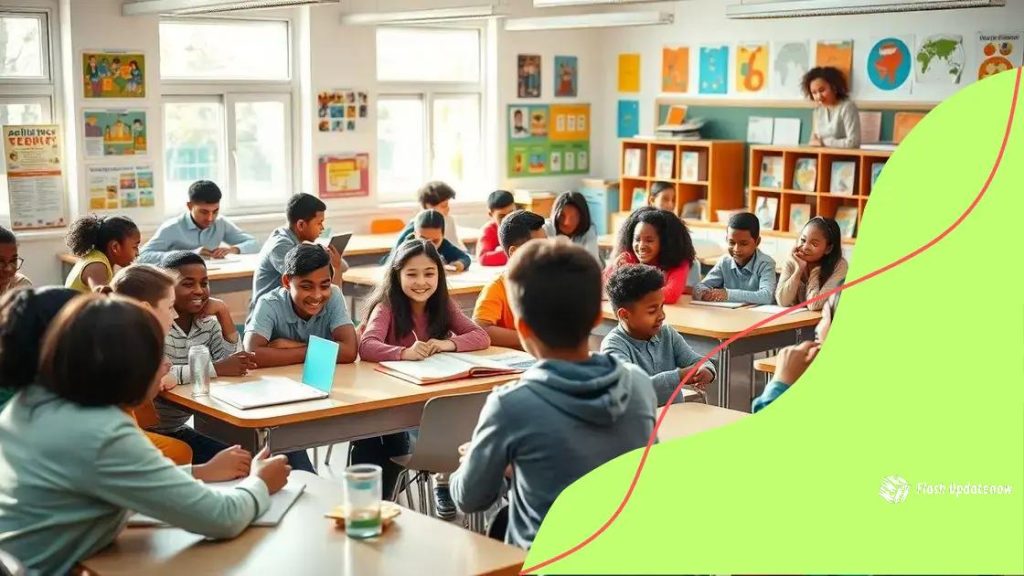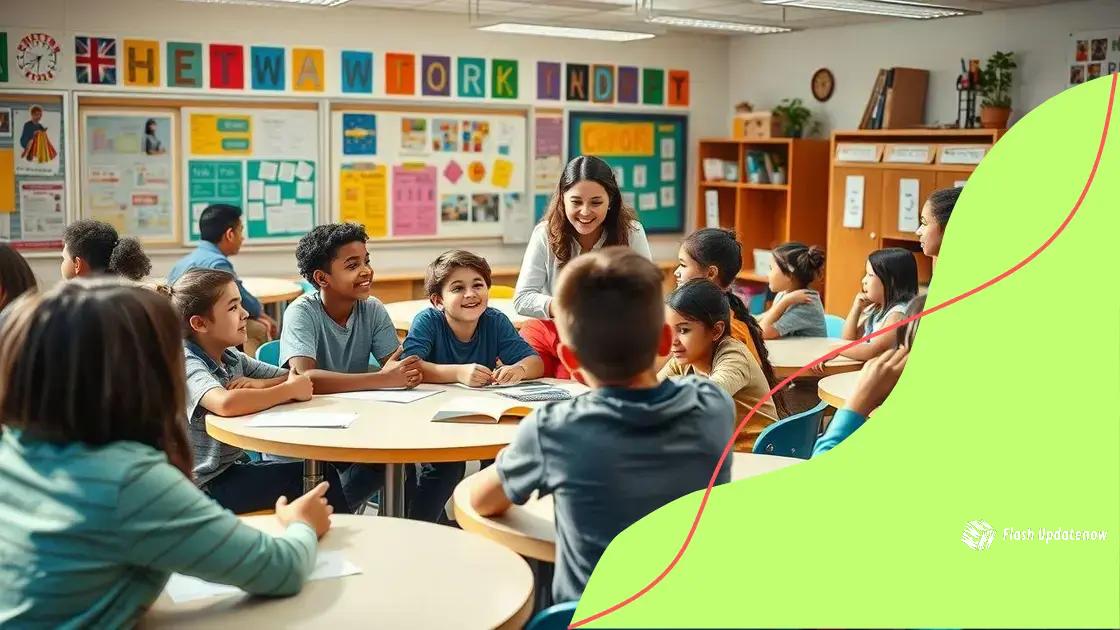Learner-centered instruction: transforming education for everyone

Learner-centered instruction focuses on the individual needs of students, enhancing their engagement, critical thinking, and ownership of learning through personalized and collaborative educational practices.
Learner-centered instruction reshapes how education is approached, focusing on the unique needs of each student. Ever wondered how customized learning experiences can drive motivation and success? Let’s explore this engaging teaching method.
What is learner-centered instruction?
Learner-centered instruction is an educational approach that focuses on the individual needs and interests of students. Instead of a one-size-fits-all method, this approach values each learner’s unique skills and perspectives.
Core concepts of learner-centered instruction
This method revolves around several key concepts that enhance student engagement. By allowing students to take charge of their learning, it fosters motivation and accountability.
- Active participation in learning
- Personalized learning experiences
- Collaboration among peers
- Continuous feedback and assessment
Moreover, learner-centered instruction emphasizes creating a supportive environment where students feel safe to express themselves. This sense of community promotes deeper understanding and retention of knowledge. Teachers become facilitators, guiding students as they explore and discover.
Benefits of the approach
The benefits of this approach are profound. When students are at the center, they tend to perform better academically. They develop critical thinking skills, learn to solve problems creatively, and become lifelong learners. Additionally, they are more likely to stay engaged in their education, leading to higher overall satisfaction.
Adopting learner-centered instruction can initially seem challenging for educators. However, integrating small changes can lead to significant impacts. For instance, incorporating group projects or allowing students to choose topics for research can enhance interest and ownership of learning.
Ultimately, learner-centered instruction isn’t just about teaching; it’s about fostering an environment where students thrive. This method paves the way for a more inclusive and effective educational landscape.
Key principles of learner-centered instruction
The key principles of learner-centered instruction shape a dynamic educational environment. This approach emphasizes understanding each student’s learning style and needs, leading to richer educational experiences.
Active learning
Incorporating active learning is vital. This means students engage in hands-on activities that promote critical thinking. Instead of passively receiving information, they participate in discussions, group work, and problem-solving exercises.
- Encourages collaboration with peers
- Promotes problem-solving skills
- Enhances retention of knowledge
- Fosters greater engagement
Another principle is personalization. Learner-centered instruction tailors learning experiences to fit individual backgrounds, interests, and abilities. This personalized approach keeps students invested in their own education as they work on topics that resonate with them.
Feedback and assessment
Continuous feedback is essential in this instruction model. Teachers provide timely and constructive feedback, helping students monitor their understanding and make necessary adjustments. Students also assess their own learning, promoting self-awareness and responsibility.
Creating a supportive environment is equally crucial. A space where students feel comfortable taking risks encourages exploration and learning. When students know they can make mistakes without judgment, they are more likely to delve deeper into subjects.
In summary, the principles of learner-centered instruction focus on fostering a positive and engaging learning experience. By prioritizing active learning, personalization, and constructive feedback, educators can create a more effective educational landscape.
Benefits for students and educators

The benefits of learner-centered instruction are significant for both students and educators. This approach creates an engaging and effective learning environment that meets the needs of all participants.
Empowered students
One major benefit for students is empowerment. In a learner-centered setting, students have more control over their learning. This autonomy boosts motivation and interest, as they can explore topics that fascinate them.
- Encourages responsibility for learning
- Builds confidence in abilities
- Promotes critical thinking skills
- Enhances retention of information
Furthermore, students develop essential skills like collaboration and communication as they work together on projects and discussions. They learn to respect diverse perspectives and ideas, preparing them for future teamwork in academic and professional settings.
Positive teacher experiences
Educators benefit as well. With learner-centered instruction, teachers can see greater student engagement and participation. This makes lessons more dynamic and enjoyable, resulting in a more fulfilling teaching experience. Additionally, teachers often gain valuable insights into their students’ needs and learning styles.
As a result, they can adapt their teaching methods effectively. By fostering a supportive classroom atmosphere, teachers create strong relationships with their students, leading to mutual respect and collaboration.
Ultimately, both students and educators thrive in a learner-centered environment. This method not only enhances academic performance but also builds vital life skills that benefit everyone involved.
Strategies for implementing learner-centered instruction
Implementing learner-centered instruction requires effective strategies that engage students and cater to their individual needs. These strategies create an enriching learning environment where students take an active role in their education.
Fostering a collaborative environment
One of the first steps is to foster a collaborative environment. Encourage students to work in groups, share ideas, and provide support to one another. This collaborative approach helps build relationships and enhances learning.
- Use group projects to enhance teamwork
- Organize discussions to encourage sharing of ideas
- Implement peer reviews for constructive feedback
- Create learning communities for ongoing support
Another effective strategy is to integrate technology into the classroom. Utilizing educational technology can facilitate different learning styles and provide diverse resources that appeal to students’ interests.
Personalizing learning experiences
Personalizing learning is key in learner-centered instruction. Allow students to choose topics for projects, which increases engagement and accountability. This also encourages them to explore areas they are passionate about, making learning more meaningful.
Additionally, regular assessments are crucial. Rather than relying solely on traditional tests, use formative assessments that guide instruction and help understand students’ progress. This ongoing feedback allows for adjustments to be made in real-time, ensuring that each student’s needs are met.
Lastly, creating a safe learning environment encourages risk-taking and exploration. Promote open communication and support students in expressing their thoughts and challenges. When students feel safe, they are more likely to engage fully and take ownership of their learning journey.
Challenges and solutions in learner-centered environments
Implementing learner-centered instruction comes with its set of challenges. Educators often face obstacles that can hinder the effectiveness of this teaching approach. Identifying these challenges is the first step in overcoming them.
Time management
One significant challenge is time management. With a focus on individualized learning experiences, fitting all necessary curriculum into the school year becomes harder. Teachers may struggle to balance personalized instruction with required standards.
- Prioritize key learning outcomes.
- Incorporate flexible pacing for students.
- Use tools and technology to streamline tasks.
- Set clear goals for each lesson.
Another challenge is addressing diverse learning needs. Students come into the classroom with varying abilities and backgrounds. This diversity can complicate lesson planning and execution, leaving some students feeling lost while others thrive.
Classroom management
Classroom management can also be difficult in a learner-centered environment. When students are taking charge of their learning, ensuring that they stay on task and engaged can be a challenge for educators.
To tackle this, educators can establish clear expectations and routines. Teaching students self-regulation skills increases their ability to manage their own learning. Regular check-ins can keep students focused and accountable.
Moreover, fostering a supportive classroom culture helps in managing diverse needs and personalities. Encouraging peer support can create a sense of community, easing management issues and facilitating smoother interactions.
In conclusion, while challenges exist in implementing learner-centered instruction, recognizing and addressing them leads to effective solutions. With the right strategies, teachers can create an engaging and productive learning environment.
FAQ – Frequently Asked Questions about Learner-Centered Instruction
What is learner-centered instruction?
Learner-centered instruction is an educational approach that focuses on the individual needs, interests, and abilities of students, promoting engagement and ownership of their learning.
How can learner-centered instruction benefit students?
This approach encourages active participation, fosters critical thinking, and allows for personalized learning experiences, leading to higher motivation and academic success.
What strategies can educators use to implement learner-centered instruction?
Educators can use strategies such as collaborative group work, technology integration, personalized learning choices, and continuous feedback to effectively implement this approach.
What challenges might teachers face with learner-centered instruction?
Common challenges include time management, classroom management, and addressing diverse learning needs. However, these can be overcome with proper planning and supportive classroom environments.
